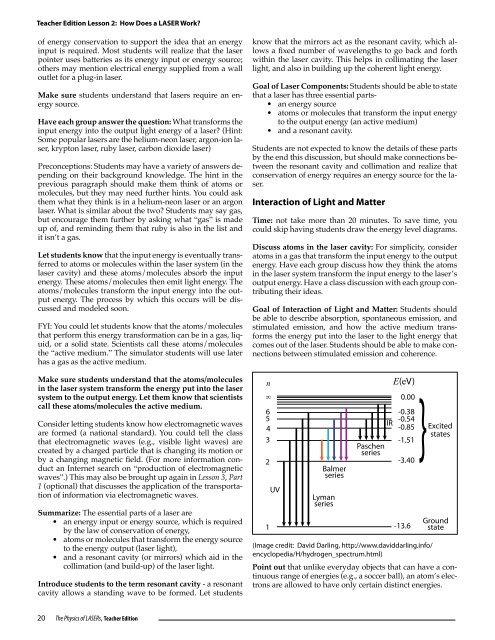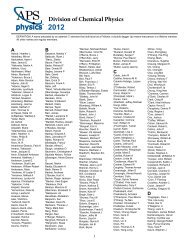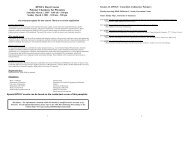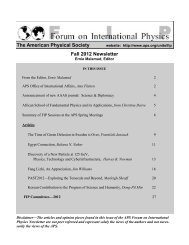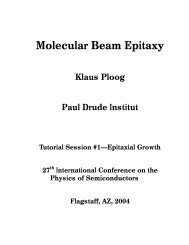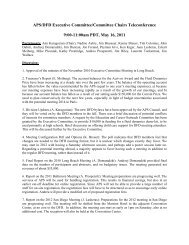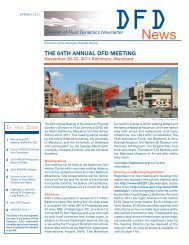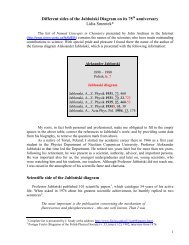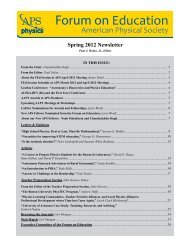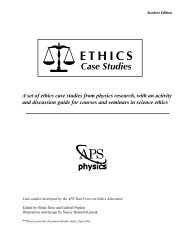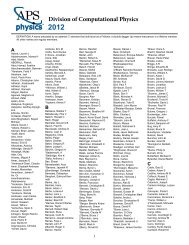The Physics of LASERs - American Physical Society
The Physics of LASERs - American Physical Society
The Physics of LASERs - American Physical Society
You also want an ePaper? Increase the reach of your titles
YUMPU automatically turns print PDFs into web optimized ePapers that Google loves.
Teacher Edition Lesson 2: How Does a LASER Work?<br />
<strong>of</strong> energy conservation to support the idea that an energy<br />
input is required. Most students will realize that the laser<br />
pointer uses batteries as its energy input or energy source;<br />
others may mention electrical energy supplied from a wall<br />
outlet for a plug-in laser.<br />
Make sure students understand that lasers require an energy<br />
source.<br />
Have each group answer the question: What transforms the<br />
input energy into the output light energy <strong>of</strong> a laser? (Hint:<br />
Some popular lasers are the helium-neon laser, argon-ion laser,<br />
krypton laser, ruby laser, carbon dioxide laser)<br />
Preconceptions: Students may have a variety <strong>of</strong> answers depending<br />
on their background knowledge. <strong>The</strong> hint in the<br />
previous paragraph should make them think <strong>of</strong> atoms or<br />
molecules, but they may need further hints. You could ask<br />
them what they think is in a helium-neon laser or an argon<br />
laser. What is similar about the two? Students may say gas,<br />
but encourage them further by asking what “gas” is made<br />
up <strong>of</strong>, and reminding them that ruby is also in the list and<br />
it isn’t a gas.<br />
Let students know that the input energy is eventually transferred<br />
to atoms or molecules within the laser system (in the<br />
laser cavity) and these atoms/molecules absorb the input<br />
energy. <strong>The</strong>se atoms/molecules then emit light energy. <strong>The</strong><br />
atoms/molecules transform the input energy into the output<br />
energy. <strong>The</strong> process by which this occurs will be discussed<br />
and modeled soon.<br />
FYI: You could let students know that the atoms/molecules<br />
that perform this energy transformation can be in a gas, liquid,<br />
or a solid state. Scientists call these atoms/molecules<br />
the “active medium.” <strong>The</strong> simulator students will use later<br />
has a gas as the active medium.<br />
Make sure students understand that the atoms/molecules<br />
in the laser system transform the energy put into the laser<br />
system to the output energy. Let them know that scientists<br />
call these atoms/molecules the active medium.<br />
Consider letting students know how electromagnetic waves<br />
are formed (a national standard). You could tell the class<br />
that electromagnetic waves (e.g., visible light waves) are<br />
created by a charged particle that is changing its motion or<br />
by a changing magnetic field. (For more information conduct<br />
an Internet search on “production <strong>of</strong> electromagnetic<br />
waves”.) This may also be brought up again in Lesson 3, Part<br />
1 (optional) that discusses the application <strong>of</strong> the transportation<br />
<strong>of</strong> information via electromagnetic waves.<br />
Summarize: <strong>The</strong> essential parts <strong>of</strong> a laser are<br />
• an energy input or energy source, which is required<br />
by the law <strong>of</strong> conservation <strong>of</strong> energy,<br />
• atoms or molecules that transform the energy source<br />
to the energy output (laser light),<br />
• and a resonant cavity (or mirrors) which aid in the<br />
collimation (and build-up) <strong>of</strong> the laser light.<br />
Introduce students to the term resonant cavity - a resonant<br />
cavity allows a standing wave to be formed. Let students<br />
20<br />
<strong>The</strong> <strong>Physics</strong> <strong>of</strong> <strong>LASERs</strong>, Teacher Edition<br />
know that the mirrors act as the resonant cavity, which allows<br />
a fixed number <strong>of</strong> wavelengths to go back and forth<br />
within the laser cavity. This helps in collimating the laser<br />
light, and also in building up the coherent light energy.<br />
Goal <strong>of</strong> Laser Components: Students should be able to state<br />
that a laser has three essential parts-<br />
• an energy source<br />
• atoms or molecules that transform the input energy<br />
to the output energy (an active medium)<br />
• and a resonant cavity.<br />
Students are not expected to know the details <strong>of</strong> these parts<br />
by the end this discussion, but should make connections between<br />
the resonant cavity and collimation and realize that<br />
conservation <strong>of</strong> energy requires an energy source for the laser.<br />
Interaction <strong>of</strong> Light and Matter<br />
Time: not take more than 20 minutes. To save time, you<br />
could skip having students draw the energy level diagrams.<br />
Discuss atoms in the laser cavity: For simplicity, consider<br />
atoms in a gas that transform the input energy to the output<br />
energy. Have each group discuss how they think the atoms<br />
in the laser system transform the input energy to the laser’s<br />
output energy. Have a class discussion with each group contributing<br />
their ideas.<br />
Goal <strong>of</strong> Interaction <strong>of</strong> Light and Matter: Students should<br />
be able to describe absorption, spontaneous emission, and<br />
stimulated emission, and how the active medium transforms<br />
the energy put into the laser to the light energy that<br />
comes out <strong>of</strong> the laser. Students should be able to make connections<br />
between stimulated emission and coherence.<br />
n<br />
5<br />
4<br />
3<br />
6<br />
2<br />
1<br />
UV<br />
Balmer<br />
series<br />
Lyman<br />
series<br />
Paschen<br />
series<br />
E(eV)<br />
0.00<br />
-0.38<br />
-0.54<br />
-0.85<br />
-1.51<br />
-3.40<br />
-13.6<br />
(Image credit: David Darling, http://www.daviddarling.info/<br />
encyclopedia/H/hydrogen_spectrum.html)<br />
Excited<br />
states<br />
Ground<br />
state<br />
Point out that unlike everyday objects that can have a continuous<br />
range <strong>of</strong> energies (e.g., a soccer ball), an atom’s electrons<br />
are allowed to have only certain distinct energies.<br />
IR


